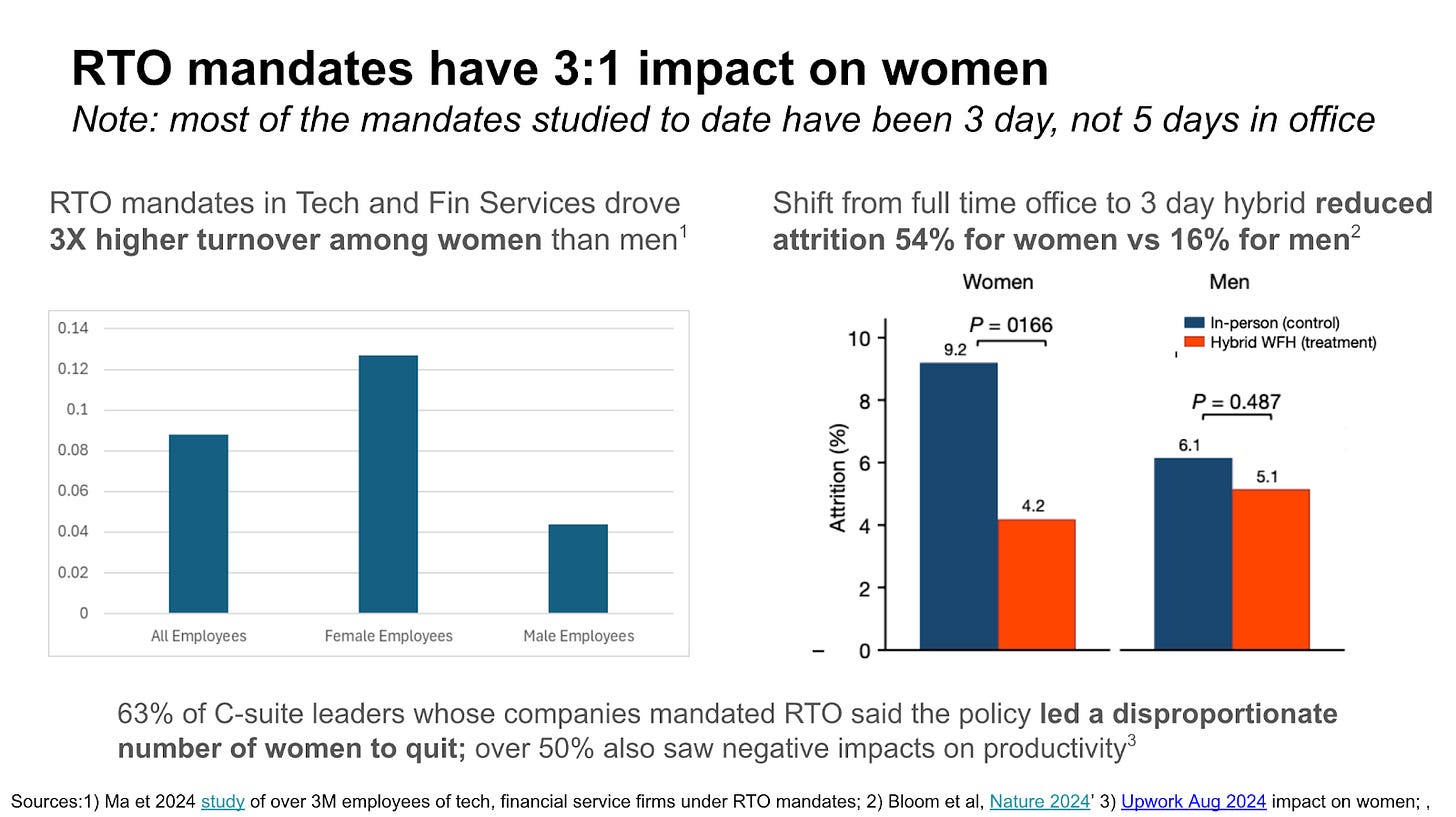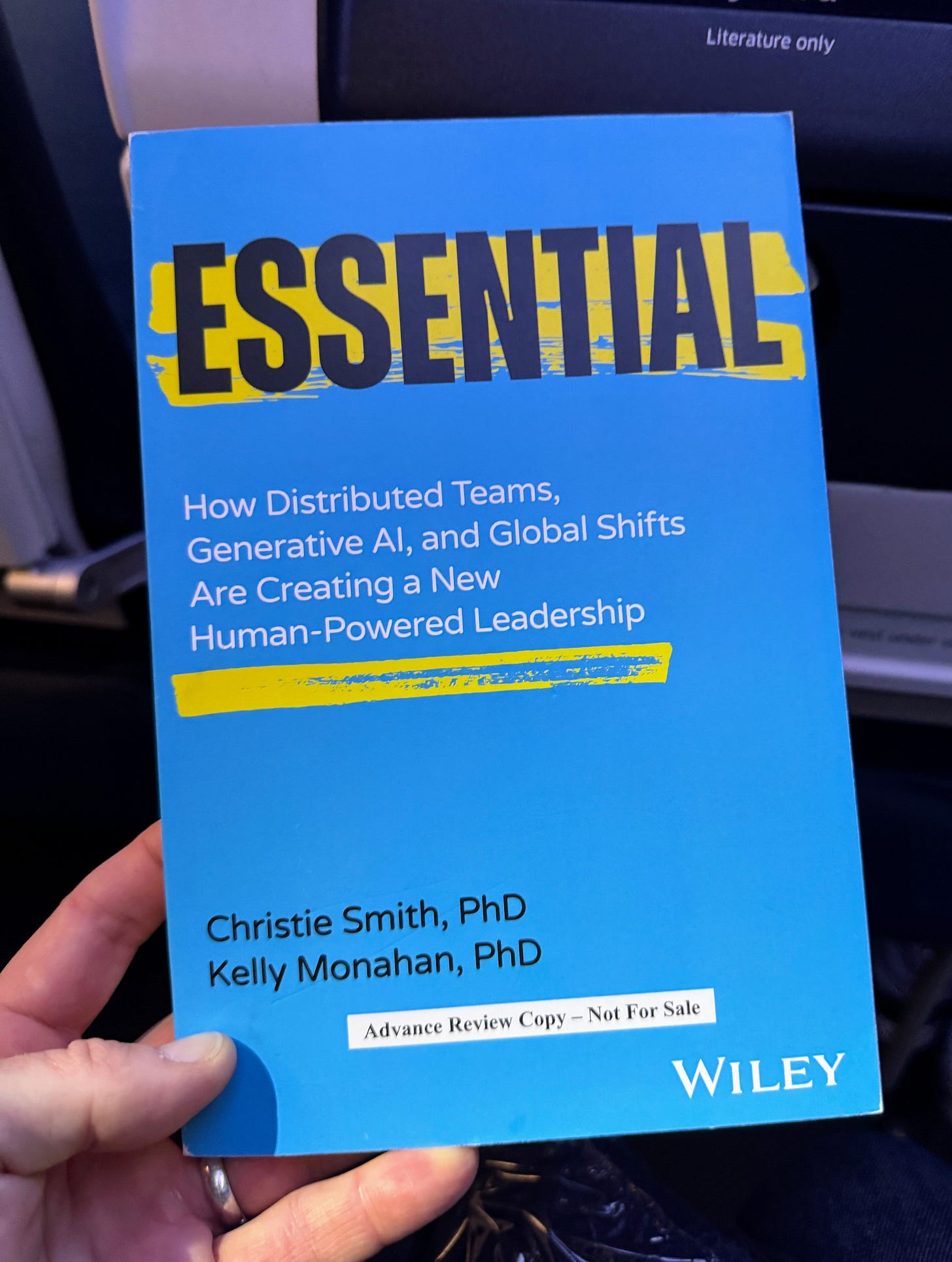Gender and the Future of Work
Successful teams need ways of working that work for everyone.
Contents
Mind the Gap
Book of the Year (so far)
Show Notes
Mind the Gap: Gender and the Future of Work
The future of work demands leaders who excel at building trust, fostering creativity, and aligning diverse teams around shared purpose. The World Economic Forum and OpenAI agree: tomorrow's success depends less on hustle and more on emotional intelligence and adaptability.
Yet many leaders are retreating to what worked for them personally—rigid, one-size-fits-all approaches that say "my way or the highway." These outdated models don't just exclude talent; they actively harm organizational performance. It's no coincidence that the average lifespan of the S&P 500 is down to 15 years.
The solution isn't just making work "better"—it's redesigning work to unlock everyone's full potential. And that starts with ensuring your definition of success works as well for women as it does for men.
Gender and Flexibility
When it comes to flexibility, one of the biggest challenges is that senior leaders often condition their beliefs about productivity on visual activity: busy offices, fast email responses, and green "available" lights.
Research on why programs like Best Buy’s ROWE (results-only work environment) get cancelled shows it’s an attitude held much more strongly by senior men – a bit of a “no kidding” realization these days. Change is hard, especially for those who’ve gotten successful through leveraging presence and hustle; I should know, I’ve been there.
But this bias has real consequences: recent research shows women are up to 3X more likely than men to leave when faced with return-to-office mandates.
These aren't underperformers — LeanIn's research shows that women who value flexibility are just as ambitious as their office-bound counterparts.
Back in 2020, Future Forum research showed that women and underrepresented groups valued flexibility more highly than others. That flexibility drove record employment of women with young children. Now, rigid return-to-office policies threaten to undo that progress.
The AI Gender Gap
Even as organizations grappled with flexibility, another gender gap emerged: AI adoption. Research last year from Slack showed men were 21% more likely to have adopted generative AI tools at work. While Deloitte recently found the gap narrowing—women now trail men by only 5% in AI adoption—the underlying challenges remain.
One bright spot: BCG found that senior women in technology roles were 11% more likely to adopt AI than their male peers. As BCG's Uche Monu explained, "Being a senior woman leader in tech already required a level of daring and risk-taking, why should adopting GenAI be different?" However, this advantage doesn't extend to junior levels, where women in technical roles still show a 7% gap.
As Erin Grau and Karin Klein point out, closing the gap has massive upside not only for women but also for organizations: when women overcome the gap, they often outperform their male counterparts. “The key differentiator? Not technical skills, but the confidence and a willingness to experiment.”
The overall gap in investment in skills is alarming. In North America, only 15% of women believe their employers are investing adequately in their skills development, compared to 22% of men – which is sad in itself.
Bridging the Divide
The path forward requires three key investments:
First, focus on outcomes, not activity. Companies like Synchrony are leading the way, replacing annual reviews with regular coaching focused on results. This creates a level playing field while driving better organizational performance. Getting leaders past the visual markers of activity as a basis for judging culture and collaboration might take a generational change in some cases, unfortunately.
Second, make learning collective, not individual. Stop expecting people to find "magic hours" for upskilling — especially when that magic would involve not being a primary caregiver. Investing in team-based training shows dramatically better results than individual programs and results in a culture of experimentation with new tools.
There’s real power in doing that work daily in small chunks with a cohort. I’ve done this with FlexOS and Almost Technical, built by the awesome team at Women Defining AI. Want an even bigger unlock? Focus on reducing repetitive work and administrative toil instead of telling people they need to “do more with less.”
Third, tackle the trust gap head-on. Flexibility in teams doesn’t work without clear frameworks: principles and team norms that people can rely on to be effective go much further than mandates and drive better performance than individual free-for-alls.
The same is true when it comes to generative AI adoption: Slack's research shows that establishing clear team norms around AI usage is crucial. Without psychological safety, many workers—especially women—will remain hesitant to experiment with new tools.
What’s at stake
Leaders shouldn’t allow and can’t afford to discount the investments needed to unlock half of the “talent market.” Organizations that fail to address these gaps will find themselves at a disadvantage in the long run.
The future of work requires more than just new tools—it demands new ways of thinking about how work gets done and how we measure success.
Leaders who recognize this and invest accordingly will build the resilient, innovative organizations of tomorrow. Those who don't will find themselves wondering why they can only attract, retain and fully engage a portion of the talent pool.
Further reading…
Erin Grau and Karin Klein’s “Women in the AI Revolution” (published as I was drafting!) is highly recommended.
I’ve also written about helping leaders see through other’s experiences, effective ways to drive AI adoption and overcoming the genAI “trough of disillusionment.”
Book of the Year (so far)
Command-and-control wants its throne back; human-centered leaders play the long game.
“People follow leaders by choice. Without trust, at best you get compliance.”
That quote from Jesse Lyn Stoner opens Essential, a great new book on human-centered leadership from Kelly Monahan and Christie Smith.
If you’re big on human-centered leadership, you might feel a bit under siege at the moment. Play the long game: human-centered leaders know how to unlock potential in people, build more resilient organizations and lead with EQ – all the factors that everyone from WEF to OpenAI say are essential to future success.
(If you’re not into human-centered leadership, you’re in the wrong newsletter.)
I’ve followed and worked with Kelly for a while now. Her and Christie’s new book is great reading for those deeply into human-centered leadership and those who are just human-curious.
“Multiple things can of course be true” (way back on page 111) stands out as a statement of broader truth than just the complexity of finding answers to loneliness and connection. So much here is relevant to today’s issues:
The challenges of “purpose washing, virtue signaling and disingenuous leadership” were problematic and led to a lot of performative DEI in 2020, the cycle has now turned to performative anti-DEI in some cases.
How hard it is to build organizations that have positive, proactive and healthy employee engagement. Trying to shut down engagement drives it outside your control; annual (or even quarterly) surveys alone are useless.
The rise of the unicorn job, the challenges of building a career when half the skills needed will be disrupted in a matter of 3 to 5 years.
The power of transparent communication and continuous performance feedback on well-being, versus the focus on meditation apps.
Pick up a copy, and if you’ve got folks on your team interested in being great leaders, share it with them too.
Show notes
Work Forward is written by Brian, a human. I use tools to help me edit (thanks Claude Project with my brand and tone guidelines) and the occasional AI-generated image. My wonderful spouse and partner in life also let me know when I let said AI editor turn my intro ‘graph into corporate crapola.
As my wonderful editors at MIT Sloan Management Review and Charter know, I can be a bit wordy. They do a much better job turning my coal into zirconium, so make sure you follow me on their platforms.
This newsletter is free, at least for now. I’d rather share everything than make a few bucks. That said, it ain’t cheap paying for all these tools. Donations of buying a paid sub are appreciated.
If you’ve read this far, I owe you a drink. I’ll buy, you give me feedback.




Commenting for the drink Brian. You are right in your observations here and I strongly believe 2025 is the year of forks. We are moving away from right and wrong, from black and white, to an era where there is no right answer or one way of doing things. 50 shades of grey will prevail to identify the right solution, in the moment that an organisation is. And this will require right partnership of expertise.